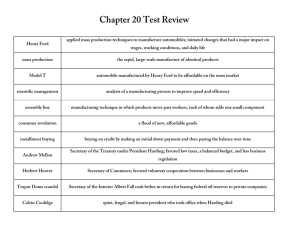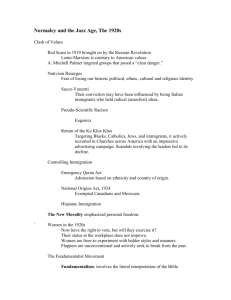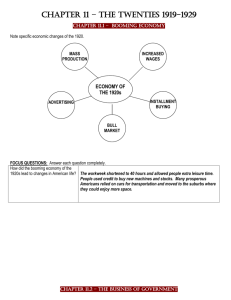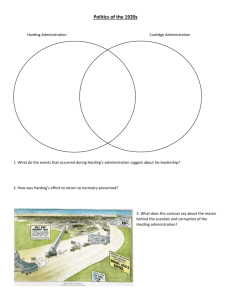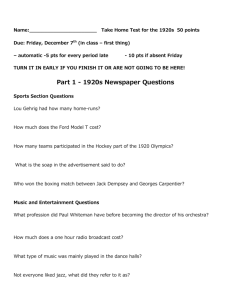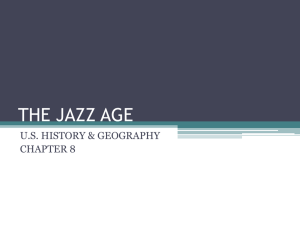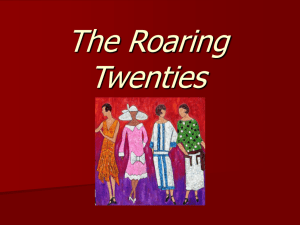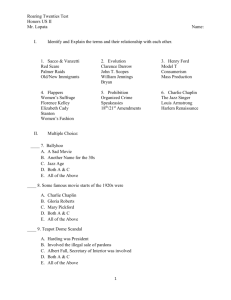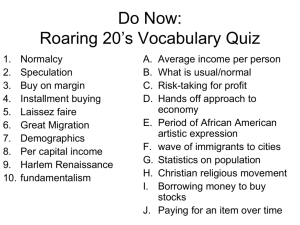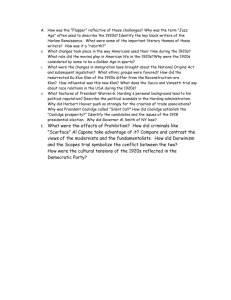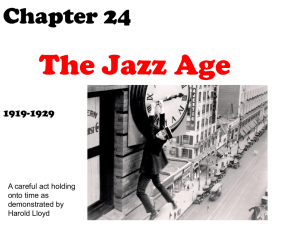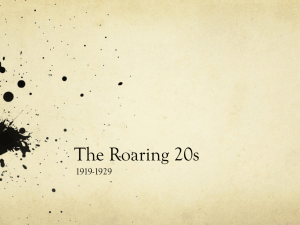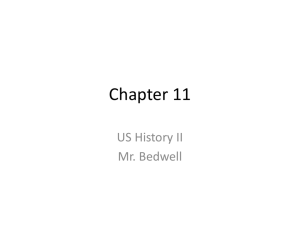14_Chapter_24_Roaring_20s_files/ch 24 summary en
advertisement
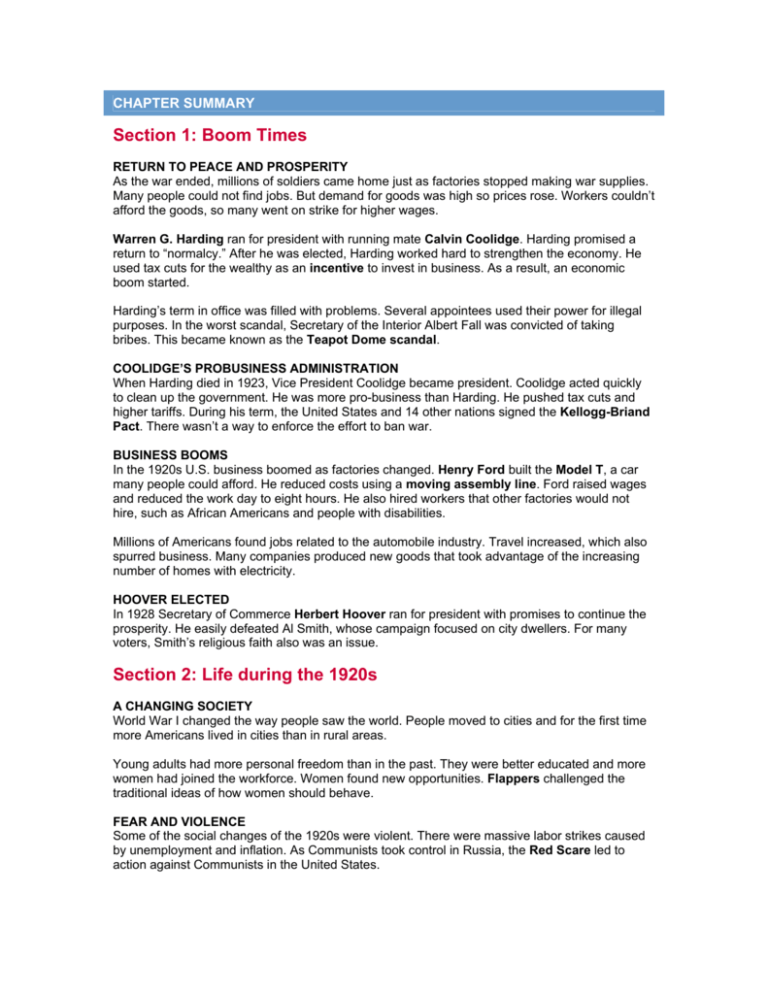
CHAPTER SUMMARY Section 1: Boom Times RETURN TO PEACE AND PROSPERITY As the war ended, millions of soldiers came home just as factories stopped making war supplies. Many people could not find jobs. But demand for goods was high so prices rose. Workers couldn’t afford the goods, so many went on strike for higher wages. Warren G. Harding ran for president with running mate Calvin Coolidge. Harding promised a return to “normalcy.” After he was elected, Harding worked hard to strengthen the economy. He used tax cuts for the wealthy as an incentive to invest in business. As a result, an economic boom started. Harding’s term in office was filled with problems. Several appointees used their power for illegal purposes. In the worst scandal, Secretary of the Interior Albert Fall was convicted of taking bribes. This became known as the Teapot Dome scandal. COOLIDGE’S PROBUSINESS ADMINISTRATION When Harding died in 1923, Vice President Coolidge became president. Coolidge acted quickly to clean up the government. He was more pro-business than Harding. He pushed tax cuts and higher tariffs. During his term, the United States and 14 other nations signed the Kellogg-Briand Pact. There wasn’t a way to enforce the effort to ban war. BUSINESS BOOMS In the 1920s U.S. business boomed as factories changed. Henry Ford built the Model T, a car many people could afford. He reduced costs using a moving assembly line. Ford raised wages and reduced the work day to eight hours. He also hired workers that other factories would not hire, such as African Americans and people with disabilities. Millions of Americans found jobs related to the automobile industry. Travel increased, which also spurred business. Many companies produced new goods that took advantage of the increasing number of homes with electricity. HOOVER ELECTED In 1928 Secretary of Commerce Herbert Hoover ran for president with promises to continue the prosperity. He easily defeated Al Smith, whose campaign focused on city dwellers. For many voters, Smith’s religious faith also was an issue. Section 2: Life during the 1920s A CHANGING SOCIETY World War I changed the way people saw the world. People moved to cities and for the first time more Americans lived in cities than in rural areas. Young adults had more personal freedom than in the past. They were better educated and more women had joined the workforce. Women found new opportunities. Flappers challenged the traditional ideas of how women should behave. FEAR AND VIOLENCE Some of the social changes of the 1920s were violent. There were massive labor strikes caused by unemployment and inflation. As Communists took control in Russia, the Red Scare led to action against Communists in the United States. Some people saw immigrants as a threat to their jobs and culture. This led to a fear of foreigners. Laws were passed to restrict the number of immigrants. The Quota Act of 1921 gave preference to immigrants from Western Europe. The National Origins Act of 1924 banned immigration from East Asia. COMPETING IDEALS Differences were also growing between older rural traditions and modern urban society. One issue was prohibition, which was hard to enforce. It led to corruption and created new ways for criminals to get rich. In 1933 prohibition was ended by the Twenty-first Amendment to the Constitution. Religious leaders saw a move away from traditional values. In response fundamentalism grew strong in rural areas. The fundamentalists believed in an exact, word-for-word reading of the Bible. They believed that scientific theories such as evolution contradicted the Bible. The Scopes trial was the center of a national debate over modern science and religious values. MINORITY RIGHTS The Great Migration continued during the economic boom of the 1920s. Economic recession led to racial tensions in many cities. Minorities, including African Americans and Hispanic Americans, began fighting to protect their rights. Marcus Garvey encouraged pride in black culture. Native Americans gained the rights of citizenship and fought to protect their lands. Section 3: The Jazz Age A NATIONAL CULTURE The radio helped build a new national culture during the 1920s. People from around the country were able to share common experiences. Radio networks broadcast the same programs to hundreds of stations at a time. Movies also opened up a new, exciting means of entertainment and adventure. Fans were thrilled by the first movie with sound, or talkie. The first talkie, The Jazz Singer, appeared in 1927. Movie stars became heroes to many millions of Americans. Other people became heroes as well. Fans packed baseball stadiums and other athletic events. Pilots became nationally known as they broke flight records. New ideas such as psychoanalysis entered popular culture. POPULAR MUSIC The booming economy and new forms of entertainment caused the decade to be named the Roaring Twenties. Another nickname was the Jazz Age because jazz music became so popular. Jazz developed in New Orleans as a blend of African American spirituals, European rhythms, and West African rhythms. African Americans brought this music north during the Great Migration. Blues music was born in the rural South during slavery and became popular in the 1920s. Both jazz and the blues were musical innovations that remain popular today. WRITERS AND ARTISTS Writers and artists also changed American culture. The Harlem Renaissance included writers Langston Hughes and Claude McKay. They told of African American life in stories, poems, and plays. Many American writers told of their experiences in the United States and around the world. Young writers of the Lost Generation expressed feelings of separation from American society. Some of them formed a community of expatriates in Paris. Lost Generation writers included Ernest Hemingway and F. Scott Fitzgerald. Another was Sinclair Lewis, who became the first American to win the Nobel Prize for Literature. Painters like Georgia O’Keeffe experimented with new styles and ways to express themselves. Meanwhile, architects were designing skyscrapers that still define American city skylines today.


